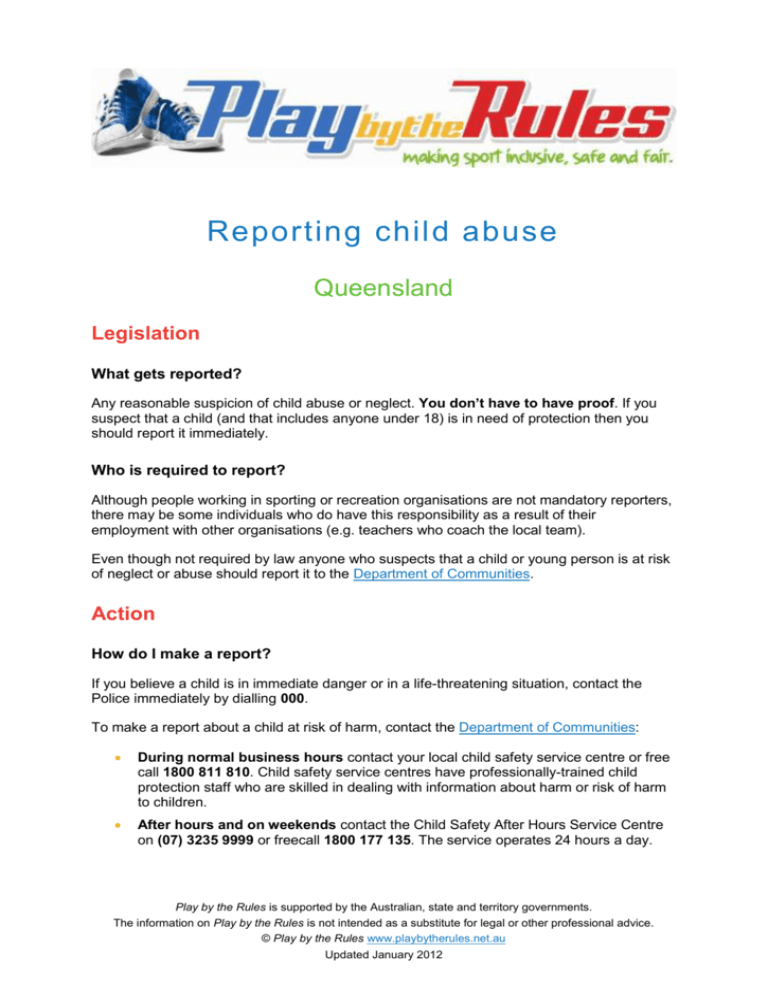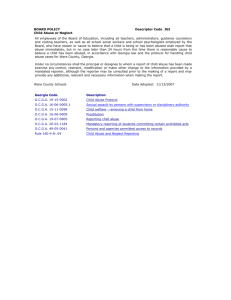
Reporting child abuse
Queensland
Legislation
What gets reported?
Any reasonable suspicion of child abuse or neglect. You don’t have to have proof. If you
suspect that a child (and that includes anyone under 18) is in need of protection then you
should report it immediately.
Who is required to report?
Although people working in sporting or recreation organisations are not mandatory reporters,
there may be some individuals who do have this responsibility as a result of their
employment with other organisations (e.g. teachers who coach the local team).
Even though not required by law anyone who suspects that a child or young person is at risk
of neglect or abuse should report it to the Department of Communities.
Action
How do I make a report?
If you believe a child is in immediate danger or in a life-threatening situation, contact the
Police immediately by dialling 000.
To make a report about a child at risk of harm, contact the Department of Communities:
During normal business hours contact your local child safety service centre or free
call 1800 811 810. Child safety service centres have professionally-trained child
protection staff who are skilled in dealing with information about harm or risk of harm
to children.
After hours and on weekends contact the Child Safety After Hours Service Centre
on (07) 3235 9999 or freecall 1800 177 135. The service operates 24 hours a day.
Play by the Rules is supported by the Australian, state and territory governments.
The information on Play by the Rules is not intended as a substitute for legal or other professional advice.
© Play by the Rules www.playbytherules.net.au
Updated January 2012
Reporting child abuse – Queensland
Useful information
How do I recognise abuse?
The Department of Communities defines child abuse as:
Physical abuse: punching, slapping, kicking, shaking, biting, applying physical
'discipline' or 'punishment' causing harm or injury
Emotional or psychological abuse: constant criticism, scapegoating, name-calling,
belittling, excessive teasing, ignoring, punishing normal behaviour, exposure to
domestic and family violence, withholding praise and affection
Neglect: failing to meet the child's basic needs for adequate supervision, food,
clothing, shelter, safety, hygiene, medical care, education, love and affection and
failure to use available resources to meet those needs
Sexual abuse or exploitation: any sexual act or sexual threat imposed upon a child
including exposure, indecent phone calls, voyeurism, persistent intrusion of a child's
privacy, penetration, rape, incest, involvement with pornography, child prostitution.
Child-safe environment strategies
Child-safe environment strategies are put in place to prevent and minimise opportunities for
child abuse within your organisation including preventing offenders from gaining access to
your organisation. They include ensuring your staff and volunteers understand their child
protection obligations and that staff and volunteers know who to go to should they have
suspicions a child may be at risk of harm.
What does establishing a child-safe environment involve?
Basically it requires putting strategies in place to prevent offenders from gaining access to
your organisation and reducing opportunities for abuse.
These strategies include:
Understanding the different types of child abuse.
Identifying potential risks and dangers to children (e.g. going away on camps) and
managing those risks.
Developing guidelines and processes that clearly outline how to respond to child protection
issues.
Choosing your staff with care.
State your commitment to a child safe environment when advertising vacant
positions.
Seek criminal history checks for employees/volunteers working with children. For
information on Queensland’s “blue card” system, visit: www.bluecard.qld.gov.au.
Conduct referee checks (particularly with previous child-related employers, if
possible).
Nominating a child protection officer or Member Protection Information Officer who people
can trust and go to with concerns.
Play by the Rules www.playbytherules.net.au
2
Reporting child abuse – Queensland
Ensuring that all staff (paid and volunteers) understand their mandatory/ethical reporting
obligations for suspected child abuse.
Ensuring staff have a clear understanding of acceptable/ unacceptable behaviour and know
who to contact to about concerns they may have.
Talking openly about the importance of ensuring the safety of children within your
organisation.
Resources
Where can I get further information or resources on reporting?
Queensland Department of Communities
Child Wise – “Choose With Care: 12 Steps to a Child Safe Organisation”
Queensland Commission for Children & Young People and Child Guardian
Play by the Rules www.playbytherules.net.au
3







